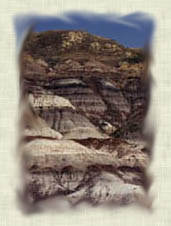
A new British Dinosaur
A new dinosaur was found in the Isle of Wight, according to The Mail on Sunday, 10 January, 1993. Apparently an enormous creature, one of the biggest ever found, it was all set to put Britain back on the `dinosaur map'. It appeared to be a new species and was discovered by a geologist named Steve Hutt. Below is a small selection from the article written about it:-
-
`Within days of finding the first bones half-way down a cliff, geologist
Steve Hutt knew he was making - and unearthing - history. For ten months
he has kept his find secret. Only now are he and his team of excavators
ready to tell the world about their discovery - a 40ft brontosaurus-like
monster which walked on what is now the Isle of Wight 120 million years
ago.
Two huge incisor teeth from another animal discovered at the scene have left intriguing clues about how this four-legged land creature died - locked, it seems, in battle with a megalosaurus, a species of tyranosaurus a fraction of its size.
Like a scene from "The Land That Time Forgot", the slow moving, vegetarian dinosaur was attacked by the predator in a swamp, partly devoured and then left to rot. The head is missing. So are sections of the neck, the tail and the back legs. But the rest of the enormous body sank to the bottom of the swamp and became covered by sediment. Over millions of years, that sediment turned to rock and the bones to fossils.
What remains is the largest complete fossil skeleton of a dinosaur ever found in Britain. "This find will rewrite the text books", said Steve Hutt. "This dinosaur doesn't even have a proper name. It is an entirely new species of sauropod."'
One can detect a hint of over-enthusiasm in the phrase `the largest complete fossil skeleton of a dinosaur'. There is no head, and sections of the tail, neck and back legs are missing. That is hardly `complete'- indeed the missing head is a very significant absentee. Steve Hutt also said that he knew he was unearthing history. All paleontologists `unearth history'. Every fossil is `historical' and just because this one is big does not necessarily make it special. If it is special, it is for reasons other than size. But these are minor points; let us consider the major ones.
On reading the extract we find that a picture is painted for us of a huge, almost docile, herbivore being attacked by a vastly smaller, vicious carnivore, dying and sinking gently to the bottom of the swamp and slowly being covered by sediment as it lay there, later to be turned into a fossil as the sediment became rock. We would therefore expect an orderly assemblage of bones with the teeth of the marauding megalosaurus, which it lost in the battle, embedded in the neck or very close together giving the impression that they had been so embedded somewhere in a vital organ. There is no easy explanation for the missing head and other parts unless we assume that the megalosaurus, or some other predator, ate them up. However, if they did that, why did they leave so much of the rest? Scavengers today are not nearly as bountiful! (The problem of predation has always been a stumbling-block to the popular theory of fossil formation, i.e. how is it that scavengers in the geological past did not remove the corpses as they do today but left the dead animal untouched for thousands - if not millions - of years?)
The bones were found in a complete jumble. The teeth of the megalosaurus were 75 inches apart (6 foot 3 inches) and not in association with any vital organ at all let alone the neck. Ask yourself these questions, `How would we have expected to find the bones if they had been subjected to a torrent of flood waters? Would the skeleton have been intact? Would significant parts have been missing? Would it have been unreasonable to find some fossil bones (teeth) of other dinosaurs washed in with the major find? Before deciding on whether the dinosaur was a herbivore or not, wouldn't it have been helpful to see its teeth and not simply judge this factor on its size alone?' The jumble of bones shrieks of death by catastrophe, not death by predation. This does not necessarily prove that it is Noah's Flood with which we are dealing - though I feel certain that it is - but we can rest assured that this dinosaur did not die and rest in peace until it was quietly covered by sediment: it was torn apart. The amazing thing is not that we have a goodly collection of its bones but that we have any bones at all to collect from the same animal lying together. Further down the article, another expert gave his views on the find and the standard sort of situation. He said, `This creature will allow us to solve many outstanding problems created by the fact that most of the early discoveries consisted of just a few bone fragments'. That is a true testimony to its size, power and strength, and to its real scientific significance.
The importance of this dinosaur to the palaeontologist is not at all in question here. What is under consideration is the method of its death and the post-mortem history of the bones. Many people read this account and have absorbed the evolutionary assumptions built in to the story. Christians can rest assured that these fossils are perfectly consistent with the biblical account of the Flood and the geological impact it made on the Earth.

